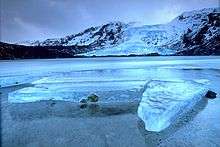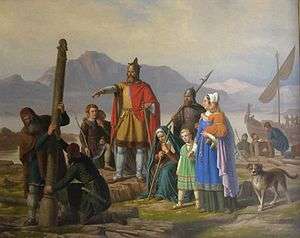Settlement of Iceland
Part of a series on the |
||||||||||||||||||||||||
|---|---|---|---|---|---|---|---|---|---|---|---|---|---|---|---|---|---|---|---|---|---|---|---|---|
| History of Iceland | ||||||||||||||||||||||||
 | ||||||||||||||||||||||||
| Middle Ages | ||||||||||||||||||||||||
|
||||||||||||||||||||||||
| Modern era | ||||||||||||||||||||||||
|
||||||||||||||||||||||||
| Related topics | ||||||||||||||||||||||||
| Timeline | ||||||||||||||||||||||||
|
| ||||||||||||||||||||||||


The settlement of Iceland (Icelandic: Landnámsöld) is generally believed to have begun in the second half of the 9th century, when Norse settlers migrated across the North Atlantic. The reasons for the migration may be traced to a shortage of arable land in Scandinavia and civil strife brought about by the ambitions of the Norwegian king Harald I of Norway. Unlike the British Isles, Iceland was unsettled land and could be claimed without conflict with existing inhabitants.
Historians typically refer to the year 874 as the first year of settlement, and the Icelandic Age of Settlement is considered to have lasted from 874 to 930, at which point most of the island had been claimed and Alþingi (Althingi), the assembly of the Icelandic Commonwealth, was founded in Þingvellir (Thingvellir). Almost everything known about the first settlers comes from Íslendingabók by Ari Thorgilsson, and Landnámabók, two historical records preserved in skin manuscripts. Landnámabók lists 435 men as the initial settlers, the majority of them settling in the northern and southwestern parts of the island.
First explorers and settlers
Gaelic monks
The Íslendingabók of Ari Thorgilsson claims that the Norse settlers encountered Gaelic monks from a Hiberno-Scottish mission when they arrived in Iceland. There is some archaeological evidence for a monastic settlement from the British Isles at Kverkarhellir cave, on the Seljaland farm in southern Iceland. Sediment deposits indicate people lived there around 800, and crosses consistent with the Hiberno-Scottish style were carved in the wall of a nearby cave.[1][2][3] The oldest known source which mentions the name "Iceland" is an 11th-century Gothic rune carving, while the oldest archeological finds indicating settlement date back to the 9th century. The first written source to mention the existence of Iceland is a book by the Goidelic monk Dicuil, De mensura orbis terrae, which dates back to 825. Dicuilus claimed to have met some monks who had lived on the island of Thule. They said that darkness reigned during winter but that the summers were bright enough to pick lice from one's clothing. While the veracity of this source may be questioned, there is little doubt that the inhabitants of the British Isles were aware of a sizeable land mass far up north. Additionally, Iceland is only about 450 kilometres from the Faroes which had been visited by Irish monks in the 6th century, and settled by the Norse around 650.
A cabin in Hafnir was abandoned between 770 and 880, showing that it was built well before the traditional settlement date of 874. It is thought to have been an outpost only inhabited part of the year, but it is not known whether it was built by people from Scandinavia or the British Isles.[4]
Naddoddr and Garðar
The Landnámabók claims that the first Norseman to rest his feet on Icelandic soil was a viking by the name of Naddoddr. Naddoddr stayed for only a short period of time, but gave the country a name: Snæland (Land of Snow). He was followed by the Swede Garðar Svavarsson, who was the first to stay over winter. At some time around 860, a storm pushed his ship far to the north until he reached the eastern coast of Iceland. Garðar approached the island from the east, sailed westward along the coast and then up north, building a house in Húsavík. He completed a full circle, circumnavigating the island and establishing that the landmass in question was indeed an island. He departed the following summer, never to return but not before giving the island a new name -- Garðarshólmur (literally, Garðar's Island). One of his men, Náttfari, decided to stay behind with two slaves. Náttfari settled in what is now known as Náttfaravík, close to Skjálfandi. Landnámabók maintains that Náttfari was not a permanent settler.
Hrafna-Flóki
“There was a man by the name Flóki Vilgerðarson. He was a great Viking. He left to find Garðarshólmur.” — Landnámabók

The second Norseman to arrive in Iceland was named Flóki Vilgerðarson, but the year of his arrival is not clear. According to the story told in Landnámabók, he took three ravens to help him find his way. Thus, he was nicknamed Raven-Flóki (Icelandic: Hrafna-Flóki). Flóki set his ravens free near the Faroe Islands. The first raven flew back to the Faroes. The second flew up in the air and then returned to the ship. However, the third flew in front of the ship and they followed its direction to Iceland.
He landed in Vatnsfjörður in the Westfjords after passing what is now Reykjavík. One of his men, Faxi, remarked that they seemed to have found great land—the bay facing Reykjavík is therefore known as Faxaflói. A harsh winter caused all of Flóki's cattle to die—he cursed this cold country, and when he spotted a drift ice in the fjord he decided to name it "Ísland" (Iceland). Despite difficulties in finding food, he and his men stayed another year, this time in Borgarfjörður, but they headed back to Norway the following summer. Flóki would return much later and settle in what is now known as Flókadalur.
 |
| A map indicating the travels of the first Scandinavians in Iceland during the 9th century |
Ingólfur Arnarson

- "There was a man of the North [Norway], Ingólfr, who is truly said to be the first leave it for Iceland, in the time when Haraldr the Fair-Haired was sixteen winters of age [...], he settled south in Reykjavík." -- Íslendingabók
Another Norseman, by the name of Ingólfur Arnarson, had instigated a blood feud in his homeland, Norway. He and his foster brother Hjörleifur went on an exploratory expedition to Iceland, and stayed over winter in what is now Álftafjörður. A few years later, they returned to settle the land with their men. When they approached the island, Ingólfur cast his high seat pillars overboard and swore that he would settle where they drifted to shore. He then sent his slaves Vífill and Karli to search for the pillars. They found his foster brother Hjörleifur murdered, and all his men gone. Ingólfur gave his foster brother a heathen funeral in the Norse style and slew the murderers, who had fled to the Westman Islands.
As winter approached, Ingólfur's slaves found the pillars by Arnarhvol. When summer came, he built a farmstead in Reykjavík and claimed all the land west of the rivers of Ölfusá, Öxará and Brynjudalsá. His slave Karli did not care for the location, and said to Ingólfur: "How ill that we should pass good land, to settle in this remote peninsula."
Age of settlement begins
The age of settlement in Iceland is considered to have begun with Ingólfur's settlement, for he was the first to sail to Iceland with the purpose of settling the land. He was followed by many others—within about sixty years, all the usable land had been taken. Landnámabók manuscripts mention 1,500 farm and place names, and more than 3,500 people. The material is arranged in a geographical fashion and seems to give a relatively complete picture of how the country was settled. Scholars estimate that between 15,000 and 20,000 people migrated to the country during the Age of Settlement. Archeological evidence strongly suggests that the timing of settlement, as described in Landnámabók, is roughly accurate; "that the whole country was occupied within a couple of decades towards the end of the 9th century."[5]
Controversial results of recent carbon dating work, published in the journal Skírnir, suggest that the country may have been settled as early as the second half of the 7th century.[6]
Age of settlement ends

The age of settlement is considered to have ended in the year 930 with the establishment of Alþingi, when almost all land in the country had been claimed by settlers and turned into the Icelandic Commonwealth.
Archeological evidence shows however "that immigrants continued to arrive in Iceland throughout the 10th century".[5] The authors of one study speculate that "continued immigration may have been needed to sustain the population".[5]
Environmental effects of settlement
Scholars have argued that the settlers caused soil erosion through extensive deforestation and overgrazing.[7] One study suggests that the primary motive for the deforestation was "clearance for pastures and home-fields", not the "settlers’ requirements for fuel and building material".[8]
See also
Notes
- ↑ http://www.rae.ac.uk/submissions/ra1.aspx?id=187&type=hei&subid=3463
- ↑ http://www.unitedessays.com/essays/0005/iceland.html
- ↑ Herdsmen & hermits: Celtic seafarers in the northern seas By Thomas Charles Lethbridge
- ↑ "New View on the Origin of First Settlers in Iceland". Iceland Review Online. 4 June 2011. Retrieved 1 July 2012.
- 1 2 3 Vésteinsson, Orri; Gestsdóttir, Hildur (2014-11-01). "The Colonization of Iceland in Light of Isotope Analyses". Journal of the North Atlantic: 137–145. doi:10.3721/037.002.sp709.
- ↑ RÚV news item http://www.ruv.is/heim/frettir/frett/store64/item310447/
- ↑ Zori, Davide Marco (2016-05-02). "The Norse in Iceland". doi:10.1093/oxfordhb/9780199935413.001.0001/oxfordhb-9780199935413-e-7.
- ↑ "The Impact of Settlement on Woodland Resources in Viking Age Iceland" (PDF).
Further reading
- Árni Daníel Júlíusson, Jón Ólafur Ísberg, Helgi Skúli Kjartansson Íslenskur sögu atlas: 1. bindi: Frá öndverðu til 18. aldar Almenna bókafélagið, Reykjavík 1989
- Byock, Jesse; Medieval Iceland: Society, Sagas and Power. University of California Press (1988) ISBN 0-520-06954-4 ISBN 0-226-52680-1
- Smith, Alfred P. (1984). Warlords & Holymen: Scotland AD 80-1000. Edward Arnold. pp. 141–174. ISBN 0-7131-6305-4.
